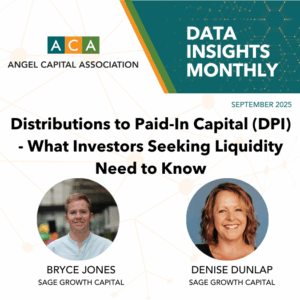In today’s early stage investing climate where exits are few and far between, angels and LPs are more focused than ever on liquidity. In this blog we are going to look at the evolution of metrics that has occurred in this segment of investing, with the primary goal of understanding what is Distributed to Paid-In Capital (DPI) and why that’s the hot metric today. We will also discuss research on the key benchmarks of DPI for recent fund vintages and showcase how Sage’s revenue-finance funds are performing from this metric’s perspective.
The Evolution of Key Metrics for Private Investors
In the world of private investing, metrics to gauge a portfolio or fund’s performance have been evolving since the pre-Dot-Com Boom Era. When angel investors first came into the scene, very few even calculated the Internal Rate of Return (IRR) on their portfolios. At that time, most VCs were mostly focused on Multiples on Invested Capital (MOIC or just MOI) or cash-on-cash multiples and basic ROIs without a measure of time. Time needs to be taken into consideration when evaluating returns because of the time value of money: $20K returned next month is not the same as $20K returned next year. It wasn’t until the 2000s when IRRs really became standardized and consistently reported on to be able to compare to other asset classes and public markets. IRR, when done properly, factors in the time value of money including the original investment date and the dates when capital is returned.
Around the 2010s, a few new metrics popped up that started to pave the path to the current standards that remain the key focus for comparing fund performance today. The metrics are DPI, Residual Value to Paid-In (RVPI) and Total Value to Paid-In (TVPI). All three serve to be snapshots at a particular time and report on slightly different aspects of the fund.
DPI measures how much capital has been returned to the investors relative to how much they have contributed. RVPI measures the current fair value of all assets held by a fund in relation to how much capital has been contributed, so it’s measuring the unrealized value of the existing assets. TVPI takes it a step further and aggregates DPI with RVPI to provide a metric that measures both the realized and unrealized returns of a particular fund at a specific moment in time.
DPI = (Cumulative Distributions) / (Paid-in Capital)
TVPI = (Total Portfolio Value) / (Paid-In Capital)
RVPI = (Residual Value) / (Paid-In Capital)
Metric | Meaning | Focus |
DPI | Realized returns | Cash returned to investors |
RVPI (Residual Value to Paid-In) | Unrealized returns only | Still-held investments |
TVPI (Total Value to Paid-In) | Realized + Unrealized returns | Total performance including current holdings |
From an LP’s perspective, DPI has pulled ahead in terms of being more commonly discussed and followed today because it is tracking the actual cash gains received versus paper gains. Here’s how to understand the values of DPI.
- DPI = 1.0 means investors have received back 100% of their invested capital.
- DPI > 1.0 means investors have received more than they invested (i.e., the fund is in profit realization).
- DPI < 1.0 means the fund has not yet returned all capital
Why DPI Matters and How to Understand It
As mentioned in the previous section, DPI measures the realized return that a fund has returned to its investors because many LPs today are more concerned with liquidity rather than the paper gains of what may occur in the future. A high DPI demonstrates that a fund has successfully exited investments and returned capital which may be an important indicator for attracting new investors who are seeking better liquidity options.
Note, one must factor in time when considering this metric because 100% DPI half way through the fund’s life versus at the end tells two different stories. The latter could be a sign of a poor performing fund; whereas, the former is doing very well. For investors with a liquidity preference, they will be more inclined to participate in a fund that consistently is achieving higher DPIs in less time. Regardless of time preferences, all LPs are still going to want their GPs to achieve 100% DPI at a minimum.
Below is a chart that shows some average DPI milestones achieved for early-stage VC funds. Some key insights to point out from these numbers are that most VCs don’t start producing DPI until the 3rd year and don’t achieve 100% until year 10 and beyond. Only the best performing funds may achieve that earlier.
FIGURE 1. DPI GROWTH OVER TIME – EARLY STAGE VC FUNDS (<$100M)

Source: Sage Growth Capital
Carta also did some DPI research on about 1,800 funds and different vintages to compare fund performance, and they found that earlier vintages were performing much better in the earlier stages of the funds’ life than compared to recent vintages. For a 2017 vintage, about 25% of funds had generated DPI after 3 years, but for a 2021 vintage, that number drops down to only 10%.
FIGURE 2. FEWER FUNDS IN RECCENT VINTAGES HAVE DPI

Obviously a lot of this is driven by market conditions and exit volumes. Earlier vintages were able to take advantage of the valuation booms and return some capital to their investors; whereas, more recent vintages have been challenged with poor exit opportunities. In the past 5 years, 2021/2022 remain the peak years for successful exits.
FIGURE 3. EXITS HAVE EVENED OUT INTO SUBDUED PACE, EVEN COMPARED TO PRE-2020

How do revenue-finance funds perform from a DPI perspective?
Revenue-financed capital (RFC), also referred to as royalty financing, revenue share or revenue-based financing, is a non-dilutive form of growth capital where investors receive a percentage of monthly revenues until a set amount has been paid. RFC differs from equity financing as the investor does not obtain ownership of the company and it differs from debt financing as there is typically no collateral required and payments are variable. Because this is a relatively new form of funding, there is not a lot of data available on the few revenue finance funds that exist.
Once this model becomes ubiquitous that may change, but for now we can only report on our own experience. Sage Growth Capital has raised two funds thus far. Fund I was more of a proof of concept and raised $2.1M in 2019. We achieved 100% DPI within the first 5 years (only 37 months after our final capital call). Sage’s Fund II raised $7.7M in 2022 and has already achieved 34% DPI within 3 years. This figure would be 53% DPI if we had distributed the first two years of payments back to the investors, however we recycled those proceeds to allow us to make more investments and further diversify the fund. These results still lead the top performing funds based on the data presented earlier.
The reason a revenue finance fund outperforms its equity fund peers is due to the way our investments are structured. We provide a principal investment amount with an agreed upon repayment amount and timeframe for repayment. In other words, we structure our exit as part of our investment, rather than waiting an unspecified amount of time for an unspecified return. Because of this structured exit, our investments are usually finished well before any traditional exit events that equity investors must rely on for payment. Also, since we start to receive monthly payments immediately after our investments, we are able to turn around and distribute those returns to our LPs much sooner.
RFC, however, may only be applicable to a subset of equity financing opportunities as it relies on existing or near-horizon sales revenues and sufficient margins to allow for repayment, ongoing operations and growth. In some cases, a form of RFC, Revenue Based Financing, can be used in combination with traditional equity deal structures to allow for early returns for the investors in exchange for equity that is repurchased by the company, or as a stopgap by investors in the event that a company realizes sales but does not exit after a certain amount of years post-funding.
KEY TAKEAWAYS
- While trends in evaluating fund performance will continue to evolve, DPI is a good metric for investors who are concerned with understanding the timing of liquidity between various options
If earlier returns are a priority or as protection in cases where companies may not experience an exit, investors may want to consider revenue based financing in their portfolio strategy.
AUTHOR: Bryce Jones and Denise Dunlap, Sage Growth Capital
About Sage Growth Capital
Sage Growth Capital makes revenue-financed investments in growth stage companies.







